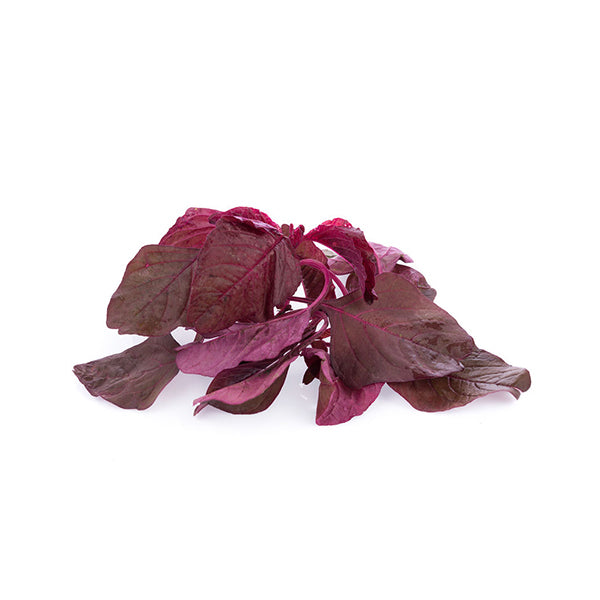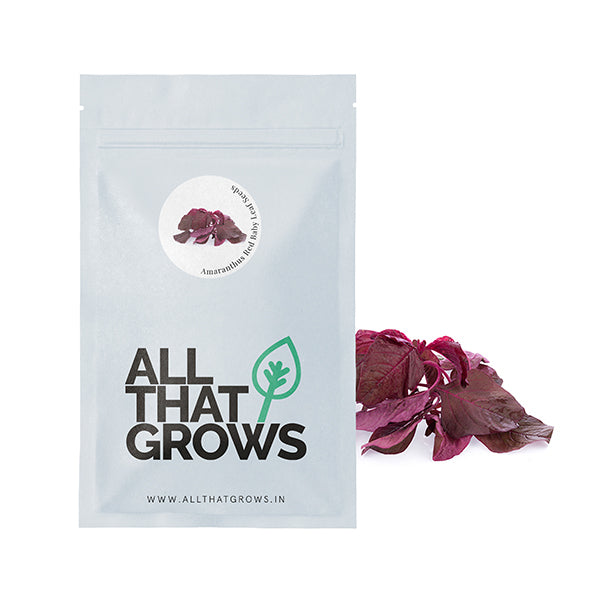



Amaranthus Red Baby Leaf Seeds
Grow this with
Seed Type : Non-Hybrid, Open Pollinated and Non-GMO
SOWING TIME : February - March, June- July
Seedling Thinning : 8 to 10 inches apart after germination
Leaf Character : Variegated purple and burgundy red leaves
Harvest : 20 to 30 days after germination
- SOWING
TIMEFebruary - March, June- July
- Sowing
DistancePlant To Plant - 6 to 8 inches
- Fruit
WeightN/A
- Fruit
ShapeN/A
- Days to
maturity20 to 30 days after germination
- Details
- How to sow
- Reviews
The baby leaves of amaranthus red are popping with beautiful colours and are ideal to adorn your recipes. The leaves are slightly nutty and mild when raw and taste like spinach when braised or steamed. Use them generously in your salad recipes to add some crunch and earthy tones or saute some to add to your favourite curries. Amaranthus red baby leaves are a rich source of beta-carotene, calcium, iron and Vitamin C.
Planting instructions
When you want to add a lot of flavour to your recipes but not wait too long, grow a mix of baby leaves. Baby leaves are revered for their juicy and flavourful texture and quick harvest.
All baby leaves thrive in a rich, loamy soil. Prepare the site before planting by adding some organic compost or aged manure, it’s always best to pre-water the soil. Make sure the soil being used is well-draining and loose.
Sow the seeds at a depth of ¼ inches and cover with loose soil and keep in partial or full sun. In the case of baby leaves, the seedlings must be thinned to an average distance of 3-6 inches apart.
Most seeds will start germinating in two to three weeks depending on the soil temperature. Plant your favourite baby leaf seeds every two weeks for a constant supply of baby greens.
Growing Requirements
pests & diseases
Some common pests that can affect baby leaves while growing are aphids, flea beetles, thrips. Moreover, some diseases like leaf spot, bottom rot, and damping-off are some water-borne diseases that can affect baby leaves. They can be managed easily with a regular check-up and organic solutions like neem spray or grapefruit seed extract.
soil
Baby leaf or baby green seeds will thrive in rich, well-draining loamy soil that is not too compact. Mix some aged manure or organic compost in your potting soil to improve soil fertility. Ensure there are no clumps in the soil since that can hamper the germination of the seeds.
spot
All baby leaves do well in partial sun or full sun depending on the local climate. Baby leaves are harvested when they are tender, therefore, it is important to protect them from harsh weather in extreme heat or cold. Put some shade in place once the daytime temperature is more than 28-30℃.
temperature
The ideal soil temperature for germination of baby leaf seeds ranges between 18 to 23℃.
watering
Baby leaves do not require excessive watering. However, in summers, the topsoil may tend to dry out relatively quickly. Hence it’s important to keep a regular check on plants. Keep the soil evenly moist with light watering.
how to harvest
The days to harvest baby leaves usually averages between four to six weeks after germination. Once the baby leaves are 4-5 inches in length, it’s time to start harvesting them. Snip the required amount of baby leaves with a pair of scissors about one inch above the soil surface and use after washing. Some baby leaves will regrow for perpetual harvesting. It is best to harvest baby leaves fresh when required, or they can be stored in sealed containers for a week in the refrigerator. Toss them with your favourite salads or top of your sandwiches with these flavourful greens.

The productiveness of any seed we sell is subject to your local climatic conditions*, the sowing method you adopt, and your commitment to the planting process. We give no warranty, expressed or implied, and are in no way responsible for the produce.
Please note that all our seasonal recommendations/ sowing information is as per the local climatic conditions. *For more information on the optimum conditions required for growing seeds in your region, please contact us at, hello@allthatgrows.in or Whatsapp us at, +91 8544865077
Questions & Answers
Have a Question?
Be the first to ask a question about this.




Amaranthus Red Baby Leaf Seeds
Seed Type : Non-Hybrid, Open Pollinated and Non-GMO
SOWING TIME : February - March, June- July
Seedling Thinning : 8 to 10 inches apart after germination
Leaf Character : Variegated purple and burgundy red leaves
Harvest : 20 to 30 days after germination
Grow this with
The baby leaves of amaranthus red are popping with beautiful colours and are ideal to adorn your recipes. The leaves are slightly nutty and mild when raw and taste like spinach when braised or steamed. Use them generously in your salad recipes to add some crunch and earthy tones or saute some to add to your favourite curries. Amaranthus red baby leaves are a rich source of beta-carotene, calcium, iron and Vitamin C.
Seed Type : Non-Hybrid, Open Pollinated and Non-GMO
SOWING TIME : February - March, June- July
Seedling Thinning : 8 to 10 inches apart after germination
Leaf Character : Variegated purple and burgundy red leaves
Harvest : 20 to 30 days after germination
- SOWING
TIMEFebruary - March, June- July
- Sowing
DistancePlant To Plant - 6 to 8 inches
- Fruit
WeightN/A
- Fruit
ShapeN/A
- Days to
maturity20 to 30 days after germination
Planting instructions
When you want to add a lot of flavour to your recipes but not wait too long, grow a mix of baby leaves. Baby leaves are revered for their juicy and flavourful texture and quick harvest.
All baby leaves thrive in a rich, loamy soil. Prepare the site before planting by adding some organic compost or aged manure, it’s always best to pre-water the soil. Make sure the soil being used is well-draining and loose.
Sow the seeds at a depth of ¼ inches and cover with loose soil and keep in partial or full sun. In the case of baby leaves, the seedlings must be thinned to an average distance of 3-6 inches apart.
Most seeds will start germinating in two to three weeks depending on the soil temperature. Plant your favourite baby leaf seeds every two weeks for a constant supply of baby greens.
Growing Requirements
pests & diseases
Some common pests that can affect baby leaves while growing are aphids, flea beetles, thrips. Moreover, some diseases like leaf spot, bottom rot, and damping-off are some water-borne diseases that can affect baby leaves. They can be managed easily with a regular check-up and organic solutions like neem spray or grapefruit seed extract.
soil
Baby leaf or baby green seeds will thrive in rich, well-draining loamy soil that is not too compact. Mix some aged manure or organic compost in your potting soil to improve soil fertility. Ensure there are no clumps in the soil since that can hamper the germination of the seeds.
spot
All baby leaves do well in partial sun or full sun depending on the local climate. Baby leaves are harvested when they are tender, therefore, it is important to protect them from harsh weather in extreme heat or cold. Put some shade in place once the daytime temperature is more than 28-30℃.
temperature
The ideal soil temperature for germination of baby leaf seeds ranges between 18 to 23℃.
watering
Baby leaves do not require excessive watering. However, in summers, the topsoil may tend to dry out relatively quickly. Hence it’s important to keep a regular check on plants. Keep the soil evenly moist with light watering.
how to harvest
The days to harvest baby leaves usually averages between four to six weeks after germination. Once the baby leaves are 4-5 inches in length, it’s time to start harvesting them. Snip the required amount of baby leaves with a pair of scissors about one inch above the soil surface and use after washing. Some baby leaves will regrow for perpetual harvesting. It is best to harvest baby leaves fresh when required, or they can be stored in sealed containers for a week in the refrigerator. Toss them with your favourite salads or top of your sandwiches with these flavourful greens.



 Sign In
Sign In








